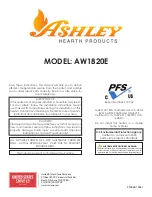
02.2020
INSTRUCTION MANUAL
for installation and operation of pellet stove
VITTORIA В*
9
Safe distances for fire safety:
When installing a pellet stove and storage of wood pellets, there must be respected with the fire requirements!
It is recommended that an appropriate place to mount a fire extinguisher.
It is forbidden to store the wood pellets directly to the pellet stove or a distance of less than 400 mm.
The optimal distance between the pellet stove and combustible materials is 1000 mm.
Inflammable objects should not be placed on the top board of the pellet stove.
If the chimney is connected to the timber wall or other inflammable material, suitable materials such as ceramic wool or similar
must isolate it.
Fresh air opening:
Imperative to ensure submission of fresh air!
The room, in which is mounted pellet stove must have an opening for fresh air with a cross section of not less than 80 cm² in
order to ensure a sufficient supply of oxygen necessary for combustion. Additionally, it can be delivered outside air through a
steel pipe of Ø 50 mm. In this case, there is possibility for emergence of condensate. If necessary, the opening for external air
can be protected by a grid whose light-section should not be less than 12 cm². Pipe for outside air has to be mounted on the
nearest outer wall to the pellet stove. Its length should not exceed 1 m, should not have curves and its location has to prevent
clogging. The outer end of the pipe must end with a knee 90˚, downward or be provided with protection against wind.
Chimneys:
Pellet stove works constantly with a fume extractor and pressure in the flue pipes and chimney.
It is forbidden the flue gases to be discharged directly from the pellet stove through the wall into the atmosphere. Required is
installed chimney, which takes flue gases to safe for human health altitude over the area of habitation.
It is recommended that the pellet stove can be installed as close as possible to the chimney in order to reduce the number of
connecting flue pipes. Pellet stove operates at low temperature regime and it is therefore possible occurrence of condensation
in the chimney, which requires more frequent inspection and cleaning.
Chimney should be used only by the pellet stove and no other appliances have to be connected to it. The flue gases are emitted
from the combustion chamber of the pellet stove to the atmosphere through a flue socket Ø 80 mm located in the rear. It is
recommended at the beginning of the vertical section of the chimney to mount a T-fitting, with a section for collecting
condensate. Pellet stove must be connected to the chimney by steel flue pipes, certified according to EN 1856. The flue pipe
system must be hermetically insulated with materials resistant to high temperatures (heat-resistant silicone or grease). Allowed
is to have a horizontal section with a length of 2 m. Horizontal section must be with minimum slope of 3% and not more than
two curves at 90°.
If the flue socket of the pellet stove is connected to a metal chimney, it must have a vertical portion length of not less than 1.5 m
and fitted with a wind protection. Chimney may be located internally or externally. It should be well insulated.
If the pellet stove is connected to a masonry chimney, it must be intended for appliances for solid fuel. If the chimney has a size
larger from Ø150 mm in diameter, internally along its entire length must be installed tube of stainless steel with a diameter of
Ø150 mm as the free space has to be isolated by masonry. All parts of the chimney should have free access to inspection. At the
bottom of the chimney must be built manhole allowing opening and cleaning at least once a year. On top of the chimney must
be installed a wind protection hat, according to current regulations.
Fig.4.
Fig 5.










































